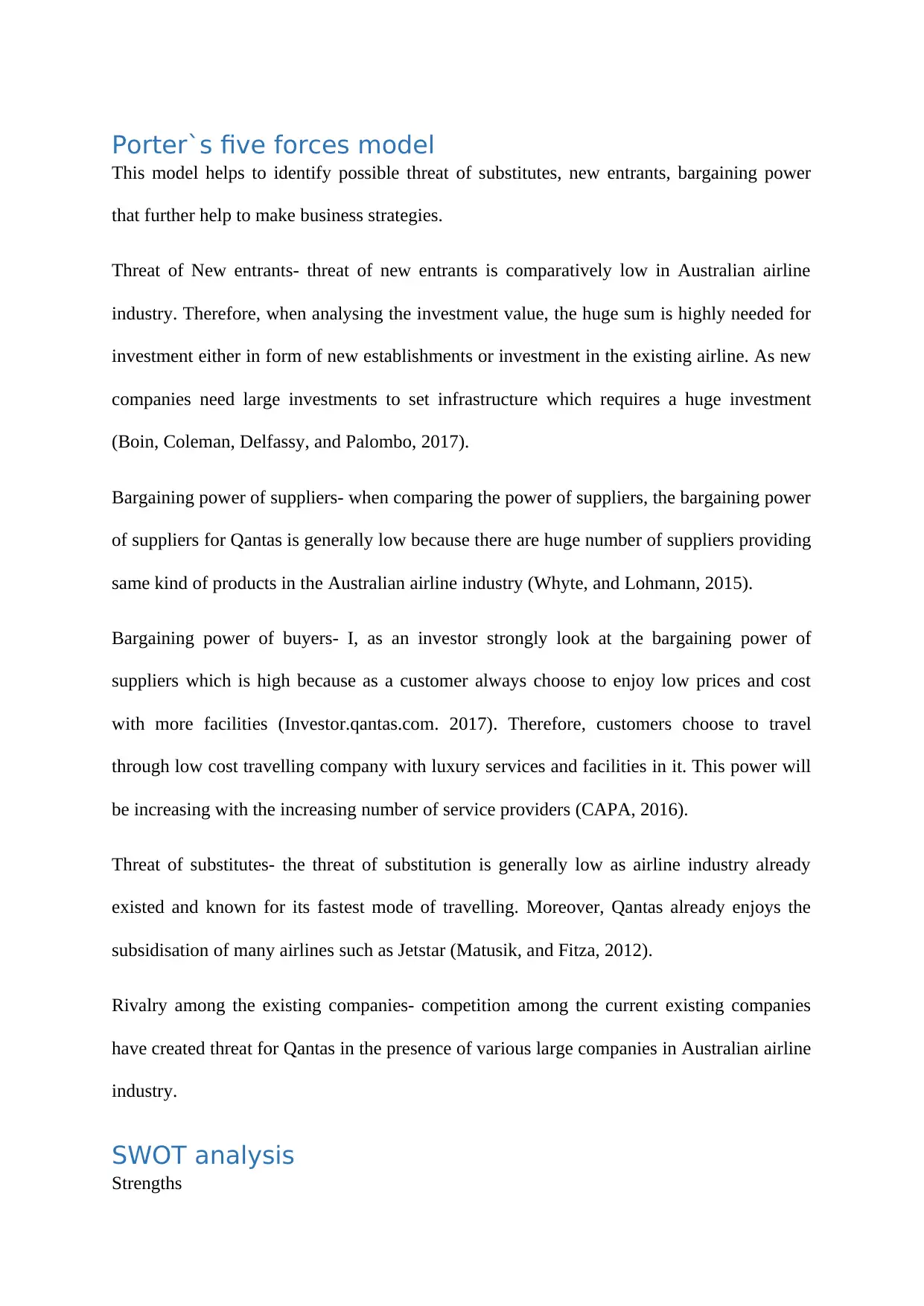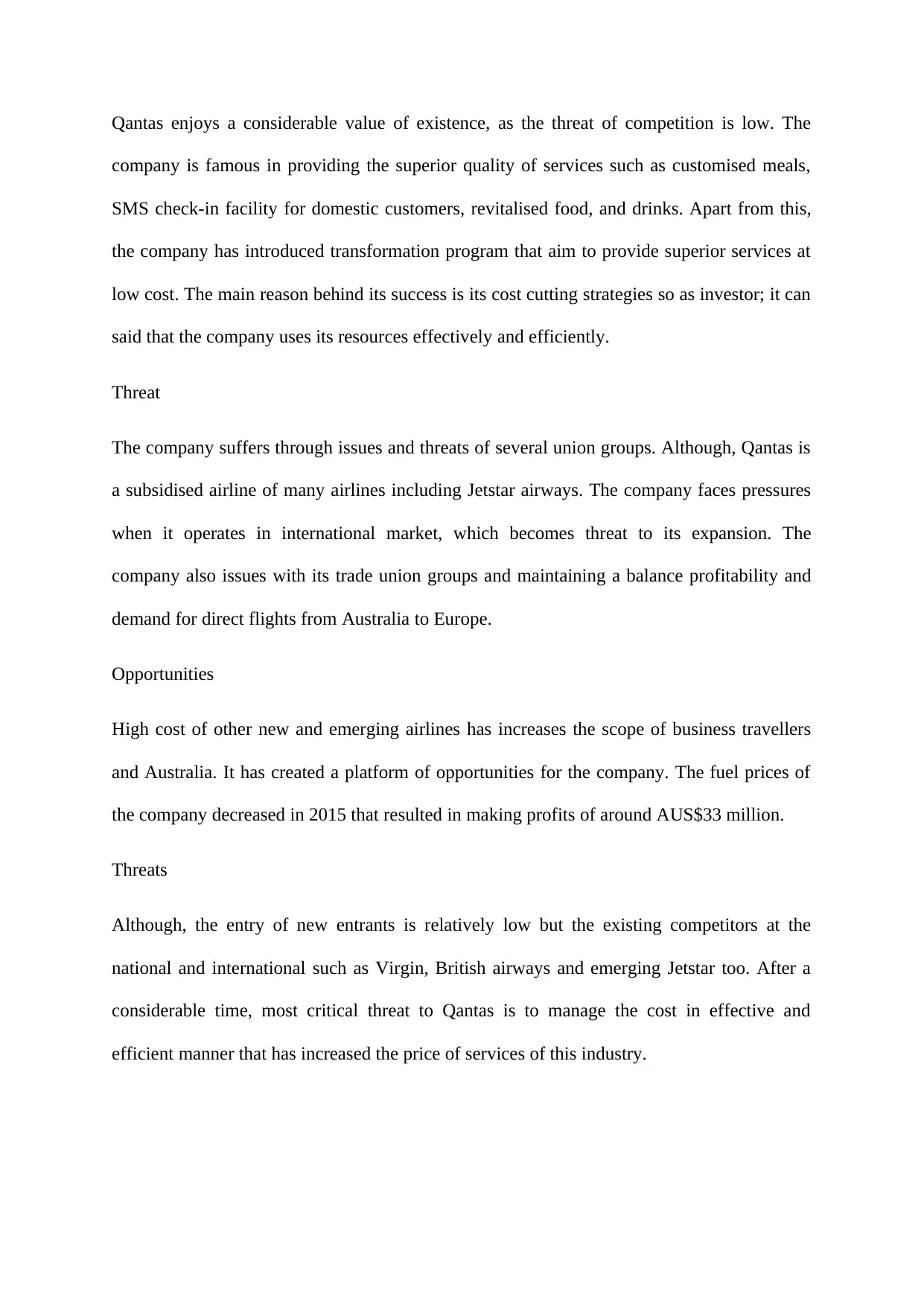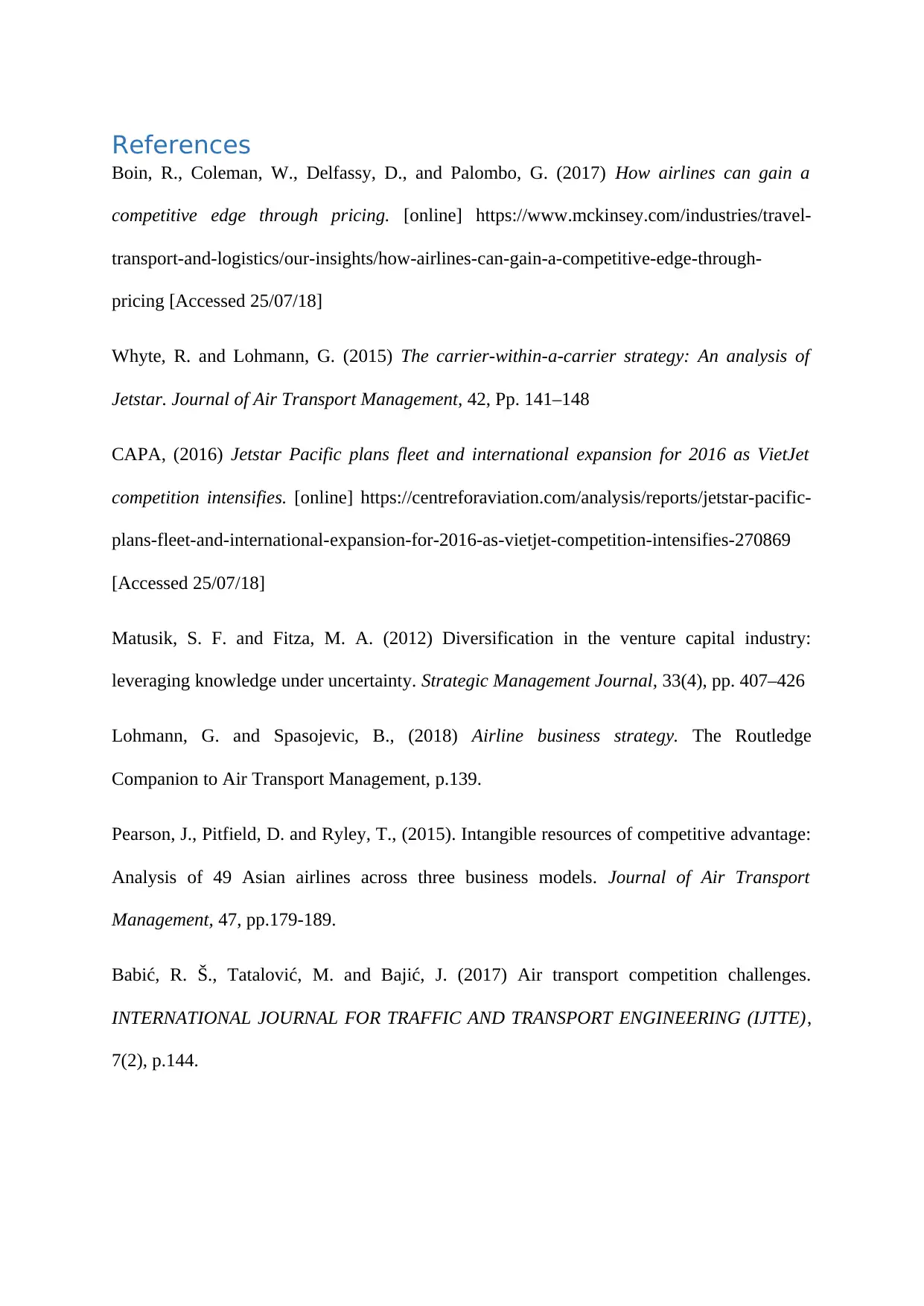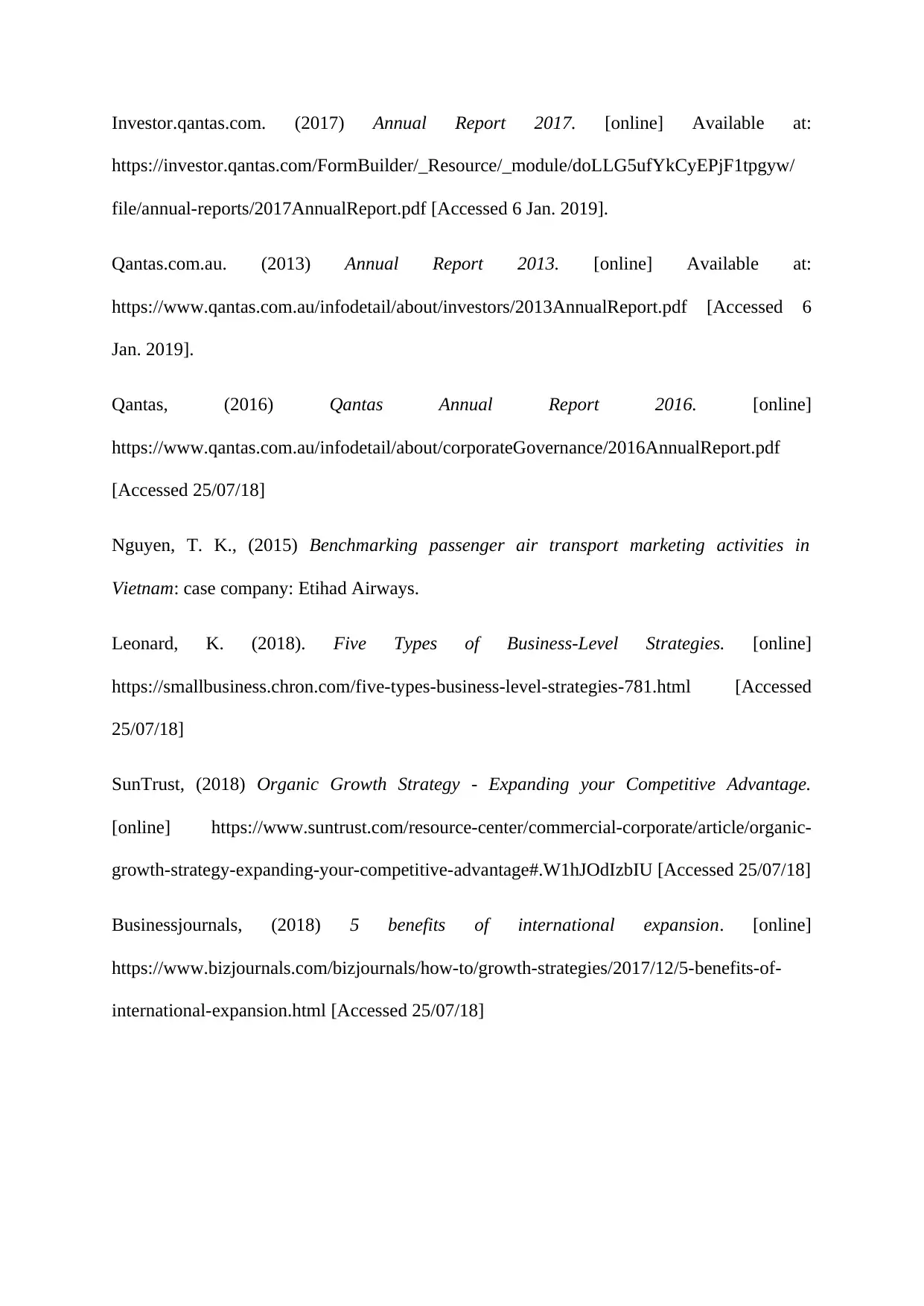B01BAVA320 - Qantas Competitive Analysis and Valuation Case Study
VerifiedAdded on 2023/04/22
|4
|985
|335
Case Study
AI Summary
This case study provides a comprehensive analysis of Qantas, utilizing Porter's Five Forces model and SWOT analysis to evaluate its competitive position in the Australian airline industry. The Porter's Five Forces analysis assesses the threat of new entrants (low), bargaining power of suppliers (low), bargaining power of buyers (high), threat of substitutes (low), and rivalry among existing companies (high). The SWOT analysis identifies Qantas's strengths (superior service quality, cost-cutting strategies), weaknesses (union issues, international market pressures), opportunities (high costs of emerging airlines, decreased fuel prices), and threats (competition from existing and new airlines, cost management). The analysis considers factors like investment requirements, supplier dynamics, customer preferences, and competitive pressures to provide a holistic view of Qantas's strategic environment and investment value.

Porter`s five forces model
This model helps to identify possible threat of substitutes, new entrants, bargaining power
that further help to make business strategies.
Threat of New entrants- threat of new entrants is comparatively low in Australian airline
industry. Therefore, when analysing the investment value, the huge sum is highly needed for
investment either in form of new establishments or investment in the existing airline. As new
companies need large investments to set infrastructure which requires a huge investment
(Boin, Coleman, Delfassy, and Palombo, 2017).
Bargaining power of suppliers- when comparing the power of suppliers, the bargaining power
of suppliers for Qantas is generally low because there are huge number of suppliers providing
same kind of products in the Australian airline industry (Whyte, and Lohmann, 2015).
Bargaining power of buyers- I, as an investor strongly look at the bargaining power of
suppliers which is high because as a customer always choose to enjoy low prices and cost
with more facilities (Investor.qantas.com. 2017). Therefore, customers choose to travel
through low cost travelling company with luxury services and facilities in it. This power will
be increasing with the increasing number of service providers (CAPA, 2016).
Threat of substitutes- the threat of substitution is generally low as airline industry already
existed and known for its fastest mode of travelling. Moreover, Qantas already enjoys the
subsidisation of many airlines such as Jetstar (Matusik, and Fitza, 2012).
Rivalry among the existing companies- competition among the current existing companies
have created threat for Qantas in the presence of various large companies in Australian airline
industry.
SWOT analysis
Strengths
This model helps to identify possible threat of substitutes, new entrants, bargaining power
that further help to make business strategies.
Threat of New entrants- threat of new entrants is comparatively low in Australian airline
industry. Therefore, when analysing the investment value, the huge sum is highly needed for
investment either in form of new establishments or investment in the existing airline. As new
companies need large investments to set infrastructure which requires a huge investment
(Boin, Coleman, Delfassy, and Palombo, 2017).
Bargaining power of suppliers- when comparing the power of suppliers, the bargaining power
of suppliers for Qantas is generally low because there are huge number of suppliers providing
same kind of products in the Australian airline industry (Whyte, and Lohmann, 2015).
Bargaining power of buyers- I, as an investor strongly look at the bargaining power of
suppliers which is high because as a customer always choose to enjoy low prices and cost
with more facilities (Investor.qantas.com. 2017). Therefore, customers choose to travel
through low cost travelling company with luxury services and facilities in it. This power will
be increasing with the increasing number of service providers (CAPA, 2016).
Threat of substitutes- the threat of substitution is generally low as airline industry already
existed and known for its fastest mode of travelling. Moreover, Qantas already enjoys the
subsidisation of many airlines such as Jetstar (Matusik, and Fitza, 2012).
Rivalry among the existing companies- competition among the current existing companies
have created threat for Qantas in the presence of various large companies in Australian airline
industry.
SWOT analysis
Strengths
Paraphrase This Document
Need a fresh take? Get an instant paraphrase of this document with our AI Paraphraser

Qantas enjoys a considerable value of existence, as the threat of competition is low. The
company is famous in providing the superior quality of services such as customised meals,
SMS check-in facility for domestic customers, revitalised food, and drinks. Apart from this,
the company has introduced transformation program that aim to provide superior services at
low cost. The main reason behind its success is its cost cutting strategies so as investor; it can
said that the company uses its resources effectively and efficiently.
Threat
The company suffers through issues and threats of several union groups. Although, Qantas is
a subsidised airline of many airlines including Jetstar airways. The company faces pressures
when it operates in international market, which becomes threat to its expansion. The
company also issues with its trade union groups and maintaining a balance profitability and
demand for direct flights from Australia to Europe.
Opportunities
High cost of other new and emerging airlines has increases the scope of business travellers
and Australia. It has created a platform of opportunities for the company. The fuel prices of
the company decreased in 2015 that resulted in making profits of around AUS$33 million.
Threats
Although, the entry of new entrants is relatively low but the existing competitors at the
national and international such as Virgin, British airways and emerging Jetstar too. After a
considerable time, most critical threat to Qantas is to manage the cost in effective and
efficient manner that has increased the price of services of this industry.
company is famous in providing the superior quality of services such as customised meals,
SMS check-in facility for domestic customers, revitalised food, and drinks. Apart from this,
the company has introduced transformation program that aim to provide superior services at
low cost. The main reason behind its success is its cost cutting strategies so as investor; it can
said that the company uses its resources effectively and efficiently.
Threat
The company suffers through issues and threats of several union groups. Although, Qantas is
a subsidised airline of many airlines including Jetstar airways. The company faces pressures
when it operates in international market, which becomes threat to its expansion. The
company also issues with its trade union groups and maintaining a balance profitability and
demand for direct flights from Australia to Europe.
Opportunities
High cost of other new and emerging airlines has increases the scope of business travellers
and Australia. It has created a platform of opportunities for the company. The fuel prices of
the company decreased in 2015 that resulted in making profits of around AUS$33 million.
Threats
Although, the entry of new entrants is relatively low but the existing competitors at the
national and international such as Virgin, British airways and emerging Jetstar too. After a
considerable time, most critical threat to Qantas is to manage the cost in effective and
efficient manner that has increased the price of services of this industry.

References
Boin, R., Coleman, W., Delfassy, D., and Palombo, G. (2017) How airlines can gain a
competitive edge through pricing. [online] https://www.mckinsey.com/industries/travel-
transport-and-logistics/our-insights/how-airlines-can-gain-a-competitive-edge-through-
pricing [Accessed 25/07/18]
Whyte, R. and Lohmann, G. (2015) The carrier-within-a-carrier strategy: An analysis of
Jetstar. Journal of Air Transport Management, 42, Pp. 141–148
CAPA, (2016) Jetstar Pacific plans fleet and international expansion for 2016 as VietJet
competition intensifies. [online] https://centreforaviation.com/analysis/reports/jetstar-pacific-
plans-fleet-and-international-expansion-for-2016-as-vietjet-competition-intensifies-270869
[Accessed 25/07/18]
Matusik, S. F. and Fitza, M. A. (2012) Diversification in the venture capital industry:
leveraging knowledge under uncertainty. Strategic Management Journal, 33(4), pp. 407–426
Lohmann, G. and Spasojevic, B., (2018) Airline business strategy. The Routledge
Companion to Air Transport Management, p.139.
Pearson, J., Pitfield, D. and Ryley, T., (2015). Intangible resources of competitive advantage:
Analysis of 49 Asian airlines across three business models. Journal of Air Transport
Management, 47, pp.179-189.
Babić, R. Š., Tatalović, M. and Bajić, J. (2017) Air transport competition challenges.
INTERNATIONAL JOURNAL FOR TRAFFIC AND TRANSPORT ENGINEERING (IJTTE),
7(2), p.144.
Boin, R., Coleman, W., Delfassy, D., and Palombo, G. (2017) How airlines can gain a
competitive edge through pricing. [online] https://www.mckinsey.com/industries/travel-
transport-and-logistics/our-insights/how-airlines-can-gain-a-competitive-edge-through-
pricing [Accessed 25/07/18]
Whyte, R. and Lohmann, G. (2015) The carrier-within-a-carrier strategy: An analysis of
Jetstar. Journal of Air Transport Management, 42, Pp. 141–148
CAPA, (2016) Jetstar Pacific plans fleet and international expansion for 2016 as VietJet
competition intensifies. [online] https://centreforaviation.com/analysis/reports/jetstar-pacific-
plans-fleet-and-international-expansion-for-2016-as-vietjet-competition-intensifies-270869
[Accessed 25/07/18]
Matusik, S. F. and Fitza, M. A. (2012) Diversification in the venture capital industry:
leveraging knowledge under uncertainty. Strategic Management Journal, 33(4), pp. 407–426
Lohmann, G. and Spasojevic, B., (2018) Airline business strategy. The Routledge
Companion to Air Transport Management, p.139.
Pearson, J., Pitfield, D. and Ryley, T., (2015). Intangible resources of competitive advantage:
Analysis of 49 Asian airlines across three business models. Journal of Air Transport
Management, 47, pp.179-189.
Babić, R. Š., Tatalović, M. and Bajić, J. (2017) Air transport competition challenges.
INTERNATIONAL JOURNAL FOR TRAFFIC AND TRANSPORT ENGINEERING (IJTTE),
7(2), p.144.
⊘ This is a preview!⊘
Do you want full access?
Subscribe today to unlock all pages.

Trusted by 1+ million students worldwide

Investor.qantas.com. (2017) Annual Report 2017. [online] Available at:
https://investor.qantas.com/FormBuilder/_Resource/_module/doLLG5ufYkCyEPjF1tpgyw/
file/annual-reports/2017AnnualReport.pdf [Accessed 6 Jan. 2019].
Qantas.com.au. (2013) Annual Report 2013. [online] Available at:
https://www.qantas.com.au/infodetail/about/investors/2013AnnualReport.pdf [Accessed 6
Jan. 2019].
Qantas, (2016) Qantas Annual Report 2016. [online]
https://www.qantas.com.au/infodetail/about/corporateGovernance/2016AnnualReport.pdf
[Accessed 25/07/18]
Nguyen, T. K., (2015) Benchmarking passenger air transport marketing activities in
Vietnam: case company: Etihad Airways.
Leonard, K. (2018). Five Types of Business-Level Strategies. [online]
https://smallbusiness.chron.com/five-types-business-level-strategies-781.html [Accessed
25/07/18]
SunTrust, (2018) Organic Growth Strategy - Expanding your Competitive Advantage.
[online] https://www.suntrust.com/resource-center/commercial-corporate/article/organic-
growth-strategy-expanding-your-competitive-advantage#.W1hJOdIzbIU [Accessed 25/07/18]
Businessjournals, (2018) 5 benefits of international expansion. [online]
https://www.bizjournals.com/bizjournals/how-to/growth-strategies/2017/12/5-benefits-of-
international-expansion.html [Accessed 25/07/18]
https://investor.qantas.com/FormBuilder/_Resource/_module/doLLG5ufYkCyEPjF1tpgyw/
file/annual-reports/2017AnnualReport.pdf [Accessed 6 Jan. 2019].
Qantas.com.au. (2013) Annual Report 2013. [online] Available at:
https://www.qantas.com.au/infodetail/about/investors/2013AnnualReport.pdf [Accessed 6
Jan. 2019].
Qantas, (2016) Qantas Annual Report 2016. [online]
https://www.qantas.com.au/infodetail/about/corporateGovernance/2016AnnualReport.pdf
[Accessed 25/07/18]
Nguyen, T. K., (2015) Benchmarking passenger air transport marketing activities in
Vietnam: case company: Etihad Airways.
Leonard, K. (2018). Five Types of Business-Level Strategies. [online]
https://smallbusiness.chron.com/five-types-business-level-strategies-781.html [Accessed
25/07/18]
SunTrust, (2018) Organic Growth Strategy - Expanding your Competitive Advantage.
[online] https://www.suntrust.com/resource-center/commercial-corporate/article/organic-
growth-strategy-expanding-your-competitive-advantage#.W1hJOdIzbIU [Accessed 25/07/18]
Businessjournals, (2018) 5 benefits of international expansion. [online]
https://www.bizjournals.com/bizjournals/how-to/growth-strategies/2017/12/5-benefits-of-
international-expansion.html [Accessed 25/07/18]
1 out of 4
Related Documents
Your All-in-One AI-Powered Toolkit for Academic Success.
+13062052269
info@desklib.com
Available 24*7 on WhatsApp / Email
![[object Object]](/_next/static/media/star-bottom.7253800d.svg)
Unlock your academic potential
Copyright © 2020–2025 A2Z Services. All Rights Reserved. Developed and managed by ZUCOL.




